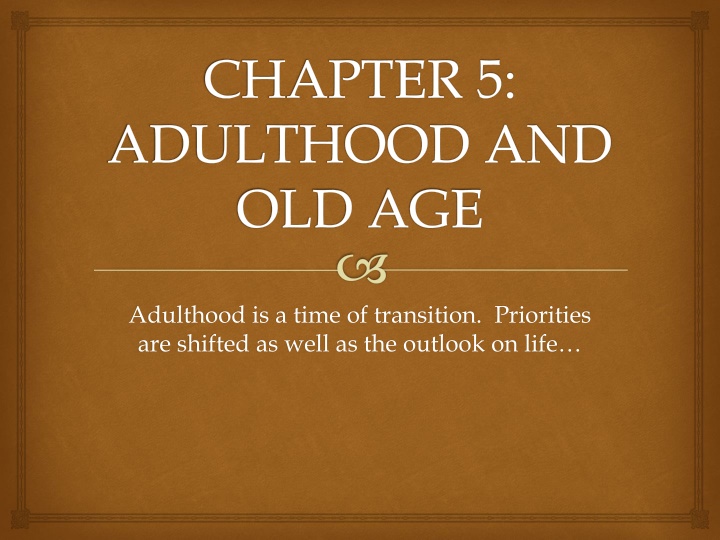
Insights into Adulthood, Aging, and Relationships
Discover the physical and cognitive changes that occur in adulthood and old age, including menopause and cognitive development. Explore the dynamics of marriage and divorce, sexual behavior, and social development. Gain valuable insights into health problems and personal growth during later stages of life.
Download Presentation

Please find below an Image/Link to download the presentation.
The content on the website is provided AS IS for your information and personal use only. It may not be sold, licensed, or shared on other websites without obtaining consent from the author. If you encounter any issues during the download, it is possible that the publisher has removed the file from their server.
You are allowed to download the files provided on this website for personal or commercial use, subject to the condition that they are used lawfully. All files are the property of their respective owners.
The content on the website is provided AS IS for your information and personal use only. It may not be sold, licensed, or shared on other websites without obtaining consent from the author.
E N D
Presentation Transcript
CHAPTER 5: ADULTHOOD AND OLD AGE Adulthood is a time of transition. Priorities are shifted as well as the outlook on life
PHYSICAL CHANGES Theory 1: our cells break down as we age Theory 2: our cells are preset to limit the number of times they can divide and multiply
PHYSICAL CHANGES CON T Physical peak reached between 18-30 Middle age: hair turns gray and thins; skin dries Eye sight and hearing fades
HEALTH PROBLEMS 3 most common causes of death in later life: 1) heart disease 2) cancer 3) cirrhosis of the liver Living a healthy lifestyle early on can prevent these
MENOPAUSE Ages 45-50 Climacteric: all the physiological and biological changes occurring at that age Menopause: the biological event in which a woman s production of sex hormones is sharply reduced
MENOPAUSE Stop ovulating and menstruating Reproduction not possible Does not reduce sex drive Not a negative experience
MARRIAGE AND DIVORCE C. 90% of U.S. adults will marry 40-60% end in divorce 2 factors to a healthy marriage: 1) how you handle conflict 2) sharing intimate and happy moments Arguing is normal
SEXUAL BEHAVIOR Sexual activity does not decline after age 40 Reasons for reduction: 1) boredom with partner 2) poor health 3) acceptance of old age stereotype
COGNITIVE CHANGES Reaction time slows We continue to learn as we age Thought flexibility improves with experience Higher education improves this
SOCIAL AND PERSONALITY DEVELOPMENT
LEVINSONS THEORY OF MALE DEV. Daniel Levinson Noticed important transition periods at 30, 40, 50, and 60 Each lasts c. 5 years
LEVINSON CONTINUED Entering the adult world Ages 22-28 Young man considered a novice Conflict: need to explore vs. stable life structure
LEVINSON The Age-Thirty Crisis 28-30 Reexamine commitments Marriage, career, life are considered
LEVINSON Settling down 36-40 Begins to carve out niche in world The BOOM phase (Becoming One s Own Man) Become fully independent Strive to attain seniority
LEVINSON Midlife Transition C. 40 Questions previous life decisions Generativity: the desire to use one s accumulated wisdom to guide future generations Stagnation: a discontinuation of development and a desire to recapture the past
LEVINSON Middle adulthood Late 40s Reaches stability Understands and tolerates others Balance between need for friends and privacy Only if not stagnant
FEMALE DEVELOPMENT Midlife could mean greater freedom Empty-Nest Syndrome: last child leaves the home Some women are happy, some are not Depression is most common in middle aged women
SECTION 2: OLD AGE Priorities and expectations change to fit reality
ATTITUDES TOWARD AGING Decremental model of aging: idea that progressive physical and mental decline are inevitable with age Ageism: prejudice or discrimination against the elderly
CHANGES IN HEALTH Strength and senses decline c. 1% a year through adulthood 40% of elderly suffer from some chronic disease 4 major chronic illnesses: Heart disease, hypertension, diabetes, arthritis
LIFE SITUATION Transitions in late life involve a reduction in responsibility and increased isolation 50% of women are widows by age 65 By age 80: 1/3 of men and 70% of women are alone
CHANGES IN SEXUAL ACTIVITY Sex can continue well into the 70s and 80s Past behavior is a good indication of future behavior
ADJUSTING TO OLD AGE Loss of body control is gradual Can lead to depression Assertive personalities tend to cope with loss better
MENTAL FUNCTIONING John Horn 2 types of intelligence: 1) Crystallized Intelligence: ability to use accumulated knowledge and learning in appropriate situations 2) Fluid Intelligence: ability to solve abstract relational problems and generate new hypotheses Fluid suffers most decline
SENILE DEMENTIA Def: decreases in mental abilities experienced by some people in old age Small percentage Memory loss, forgetfulness, disorientation, impaired attention, altered personality
ALZHEIMERS DISEASE Def: a condition that destroys a person s ability to think, remember, relate to others, and care for themselves 5.4 million Americans 6th leading cause of death in the U.S.
ALZHEIMERS Neurological disease Gradual deterioration of cognitive functioning Genetics plays a large role Cause is still not fully understood
SECTION 3: DYING AND DEATH Peace, I m out!
ADJUSTING TO DEATH Thanatology: the study of death and dying Elisabeth K bler-Ross came up with the 5 stages of psychological adjustment
STAGES OF ADJUSTMENT 1) Denial 2) Anger 3) Bargaining (mostly with a deity) 4) Depression 5) Acceptance Not all experience this It does not have to be in order
HOSPICES Hospice: a facility designed to care for the needs of the dying Meant to restore dignity to dying Home hospice is becoming more popular
